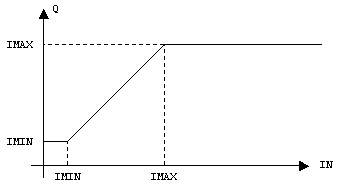
![]() A function calculates a result according to the current value of its inputs. A function has no internal data and is not linked to declared instances. - Bounds an integer between low and high limits.
A function calculates a result according to the current value of its inputs. A function has no internal data and is not linked to declared instances. - Bounds an integer between low and high limits.
Inputs
IMIN : DINT Low bound
IN : DINT Inputvalue
IMAX : DINT High bound
Outputs
Q : DINT IMIN if IN < IMIN; IMAX if IN > IMAX; IN otherwise
Function diagram

Remarks
In FFLD language, the input rung (EN) enables the operation, and the output rung keeps
the state of the input rung. In IL![]() "Instruction list"
This is a low-level language and resembles assembly language, the first input must be loaded before the
function call. Other inputs are operands of the function, separated by a coma.
"Instruction list"
This is a low-level language and resembles assembly language, the first input must be loaded before the
function call. Other inputs are operands of the function, separated by a coma.
ST Language
Q := LIMIT (IMIN, IN, IMAX);
FBD Language

FFLD Language
(* The comparison is executed only if EN is TRUE *)
(* ENO has the same value as EN *)

IL Language:
See also






